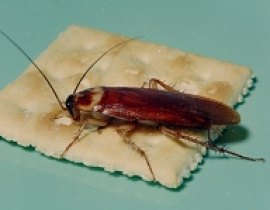Professional Pest Control & Wildlife Management
Cockroaches
Few creatures in the insect world generate as much disgust as Cockroaches. They are considered a sign of poor hygiene when in fact they can appear in the most cleanliest of homes and businesses.
Out of the 3500 known species to inhabit earth the main two types of cockroach found in the UK are the German and Oriental, however the American and Australian are also reasonably common. For more information on specific species scroll down to the 'Related' box on this page.
-
Risks
Cockroaches are vectors for some wonderful diseases including; Salmonella, Gastro-enteritis, Amoebic dysentery, Tuberculosis, Tape worm and Hookworms.
-
Treatment
Firstly we must discover the scale of the infestation as to decide on the best course of action.
To determine how bad an infestation is or if there is one, a thorough survey should be taken out, searching in cupboards, behind cookers, fridges, under sinks etc. Sticky board insect monitor traps with pheromone attractants can be a good way to identify numbers and location of harbourages. Entering a room early in the morning (2am’ish )and quickly turning on the lights will likely find some scurrying around (worth noting which way they run). Another more professional indicator is to use a flushing agent into crevices and holes etc, this will drive them out and locate there preferred harbourages.
There is two main ways of dealing with cockroaches, spray treatments (including ULV) and baiting them.
Spray treatments use residual insecticides sprayed onto floor/wall junctions, under and around likely harbourages and anywhere the roaches are likely to come into contact with them. In addition to a spray treatments, insecticidal dust can be blown behind cupboards, skirting boards, under work surfaces, into wall voids, behind sockets etc. Insect lacquers also provide a good means of control by forming long lasting barriers around affected areas.
Baiting is a more cost effective measure and uses less insecticide around the home or business. Highly palatable baits containing insecticide are placed at many different locations (only tiny amounts are used) focusing on harbourages and affected areas. The baits act quickly killing any cockroach which feeds upon them. The ingenious part of this treatment is that specially formulated roach baits then make the deceased roach a toxic bait for its cannibalistic friends, with the same bait effectively being consumed by many different cockroaches.
We use a micro encapsulated bait which gives the roach enough time to return to its harbourage before succumbing to the active ingredient. This has the effect of essentially placing a bait (the dead roach) exactly where the other roaches are hiding. This creates a domino effect and is a highly effective treatment for these tough to beat creatures
-
Life Cycle
There are differences between the cockroach species, however they do share many life cycle attributes with one and another.
Cockroaches lay eggs in an egg sack called an oothecae, these cases are hardy and can withstand insecticide treatments. Oothecae are either laid in harbourages or carried around by the mother roach until just before hatching occurs (German Cockroach).
The young roaches called are nymphs, they do not pupate merely molt into larger versions of themselves until they reach adult form.
Cockroaches are omnivorous, eating anything they can find from plants to meat and also other cockroaches ( a useful point when treating them). They drink water and are often found in sinks and baths.
Roaches are nocturnal and gregarious (that is they live together), if you have an infestation and you begin searching around your kitchen you will likely find several together hiding in a dark nook or cranny.
- False Widow Spider Removal
- Cluster Fly help
- The trouble with fleas?
- Mole Catching in Suffolk
- Rats in the Garden
- Wasp Nest Control
- Rats in your chicken Coop
- Anaphylaxis
- Bee Swarms
- Becoming a Beekeeper
- Rare Breed Poultry
- Pest Control with Birds of Prey
- Un-marked vehicles available
- Rabbiting with Ferrets
- Myxomatosis
- Poll-Tex Mesh
- Honorary Member Russell Wallis
- Free Rabbit Control


